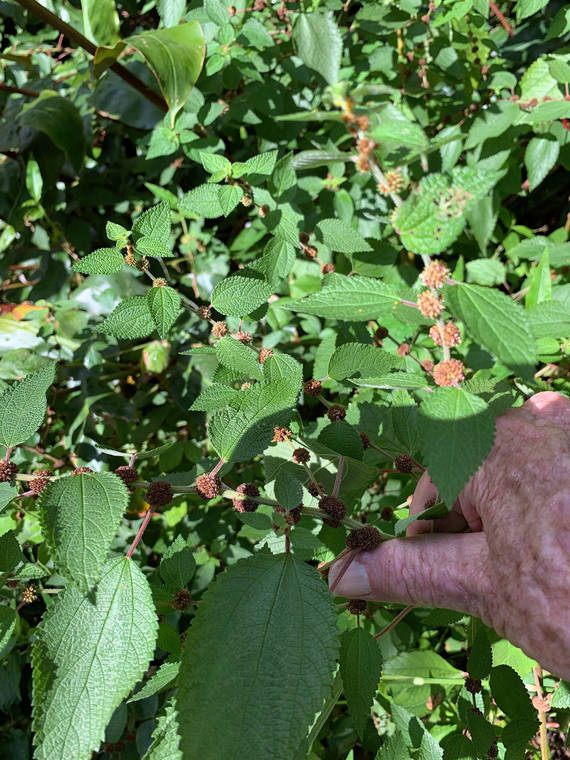Phenax hirtus is a tropical shrub that will grow rapidly to fifteen feet in height and can spread rapidly. It is originally from Central America. At first glance it looks like a small leafed version of mamake to which it is related. It is a pioneer specie that quickly invades areas sprayed with herbicide like along the forest reserve trails and in areas along roadsides where soil is exposed. Since Phenax is closely related to mamake, it may have some medicinal value.
Is it a weed? A weed may be defined as any plant growing in the wrong place. Perhaps an even better definition is “a weed is a plant for which we haven’t found value.” Just like there is no such thing as a bad child only bad behavior, there is no such thing as a bad plant. There is bad management and the spread of Phenax is a great example. When we create a vacuum by spraying herbicide or clearing our forests for example, we make conditions ideal for pioneer species to take hold.
Naupaka is a good example of a native Hawaiian coastal plant found throughout tropical Pacific islands that valuable for stabilizing sands along the beaches. We commonly use it in our landscapes. Introduced to Florida as a landscape plant, it has naturalized along the coast and does stabilize beach sands, but because it is not native, it is called an invasive specie. Perhaps a better word to describe what we call weeds would be “pioneer species” trying to heal the wounds created by man or natural events like lava flows and hurricanes.
What we call weeds in lawns are usually the result of poor management. Lawns injured by insects, fungus, or nematodes will readily become infested with pioneer species. Improper mowing, watering, and fertilization will lead to a lawn with which we are not happy. So, don’t blame what we call weeds for a poor lawn.
When it comes to turf, high quality cuttings or seed, properly established is important. Soil that is not infested with unwanted perennial plants like Wainaku grass or nut sedge is also a basis for preventing problems in a new lawn.
If you ultimately decide you must use an herbicide, then here are some things to consider.
Just like the three “R’s” of learning, we find some very important “R’s” related to the application of herbicides. These “R’s” are to the RIGHT material, at the RIGHT time, in the RIGHT amount, applied in the RIGHT way. Understanding all the instructions of an herbicide label to be sure it will control your specific problem without injuring your plants is as vital as using the right amounts. Safety margins may be smaller than you think. To apply pesticides in the right way, you must choose equipment that will give proper coverage. Spray jars that attach to your garden hose are good where you need to apply nutritional sprays, fungicides or insecticides to the lawn. However, with herbicides, it’s a better idea to use a small 2-3 gallon tank sprayer. A tank sprayer is vital since hose attachments are not accurate enough.
If you end up having to pull unwanted species by hand, smile. Let’s take a positive approach to “weeds.” Did you know that many of those seemingly pesky fellows are actually edible or medicinal?
Both the characteristics and the definitions of weed emphasize that they are plants closely related to man. They come and go as man disturbs the soil. Just as man has traveled and dominated the land, so have these species benefited from his activities.
Because of their origin so close to the activities of man, many plants we call weeds have been discovered to be edible or medicinal, and indeed may be used as beneficial herbs throughout the world.
So when you go out to pull what we call weeds, it’s easier if you know they could be for dinner or to help heal a cut or settle an upset stomach.
There are more than a hundred edible plants referred to weeds. If you are interested in these and other useful plants, check at the local library or do a computer search for Edible Leaves of the Tropics by Franklin Martin and Ruth M. Ruberte — Mayaguez Institute of Tropical Agriculture, P.O. Box 70, Mayaguez, Puerto Rico, 00708.



